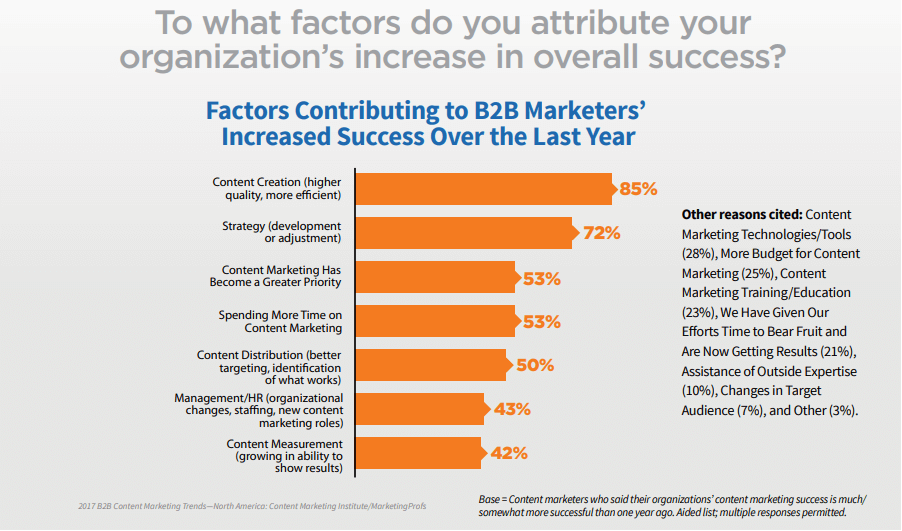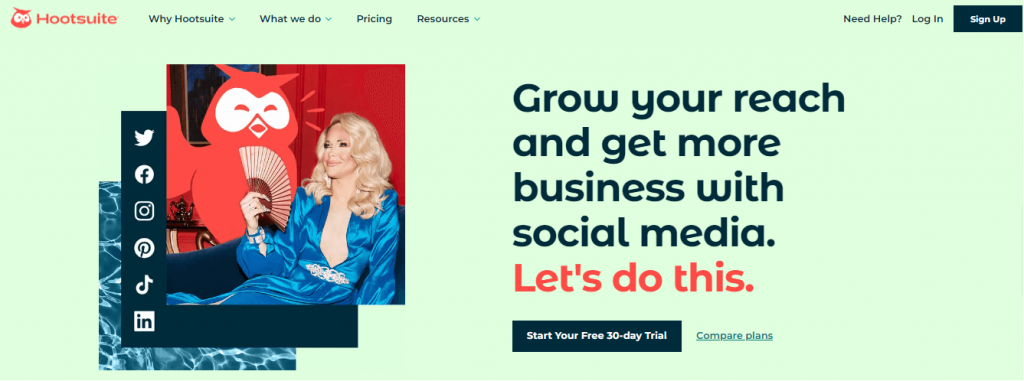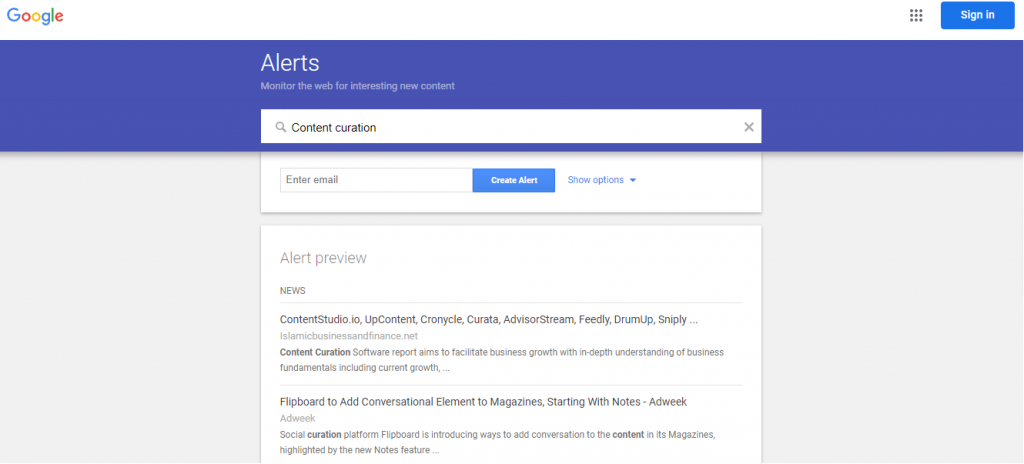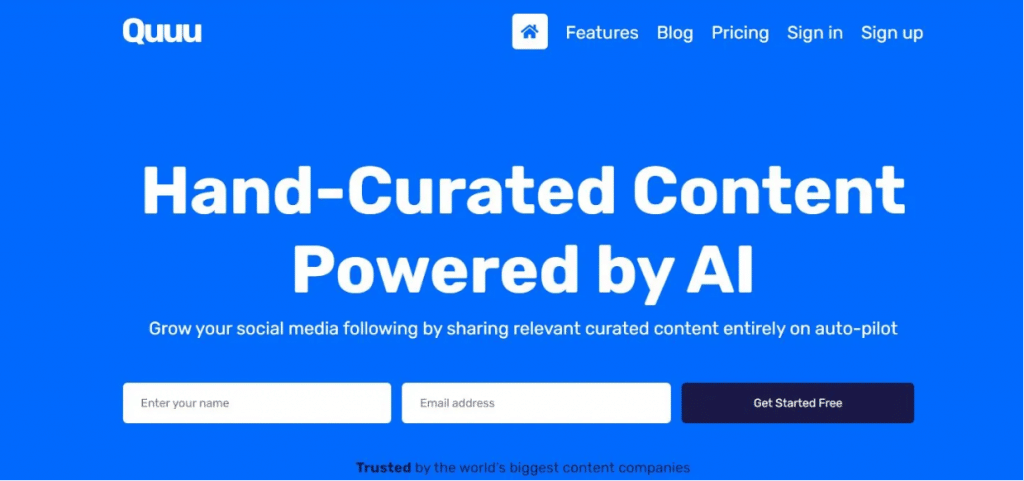Content is the heart of every business. It plays a crucial part in growing and nurturing long-lasting relationships with your audience.
Similarly, when you provide value through your content, without being overly promotional, it gives prospects a reason to trust you and your brand.
Granted, brainstorming original content ideas can be a daunting task, even for a seasoned content marketer. A survey by Content Marketing Institute suggested that 49% of B2B Marketers identified content creation as one of the challenges contributing to stagnancy in success with their content marketing efforts.

Source: CMI
With that said, a well-planned content curation strategy is the perfect solution to this problem. Finding and sharing relevant content that touches on your audience’s pain points & provides actionable solutions to their challenges can enrich your industry presence.
It also allows you to establish yourself as a thought leader in your industry/niche. When you tap into your audience in this way, your editorial calendar is sure to be overflowing with exciting content ideas.
85% of B2B Marketers strongly believe that content curation contributes to the success of their organization.

Source: CMI
In this article, you’ll learn how to improve your readership reach with a content curation strategy.
What Is Digital Content Curation?
Content curation is the careful selection and piecing together of relevant content from different reputable sources (blog posts, infographics, and even webinars) into a resourceful piece.
Here, content marketers source the best pieces across different niches or industries and share this valuable compilation with their readers.
There’s no two ways about it, content curation is a fundamental aspect of a great content marketing strategy.
With over 7 million pieces of content posted daily and the ever-dwindling attention spans of readers, marketers have to prioritize curating only the best and most resourceful content for their audience.
What Are the Benefits of Content Curation?
When you curate content and let the author know by tagging them in your post, it opens the door to the opportunity to network with other industry experts. You can reach out to them directly or send a DM.
Besides credibility, crediting your source could be the start of a fruitful professional relationship between you and the author.
Additionally, content curation can spark awareness about your brand. You won’t be limited to creating content from the ground up in order to build awareness about your brand. You can share other quality content on subjects connected to your brand to engage your audience.
Furthermore, promoting content that mentions your brand highlights the value you bring to the table. If you’re not already convinced, here are some of the other benefits of content curation:
Position Yourself as a Thought Leader in Your Industry/Niche
When you’ve been gathering content from a broad range of reputable sources for a while, you acquire in-depth knowledge of industry insights and trends.
The true essence of thought leadership is the creation of value and gathering resourceful pieces to position yourself as an expert in your industry or niche.
Enrich Your Content Calendar
Content curation can alleviate mounting pressure on your small marketing team to constantly create original content from scratch.
Instead, you can distribute content that resonates with your audience. That way, you can keep your content calendar filled all year long with exciting content ideas.
Improve Your SEO
Curated content often includes links to trusted and authoritative websites – which also play a part in helping you rank high on SERPs.
When your best content ranks higher, the traffic you get on your website also increases.
Save Time and Resources
With content curation, you can manage your small team of marketers. You won’t need to deal with the hassle of hiring extra writers and designers to help you create original content.
The best part is that you won’t be sacrificing your relevance in the industry.
8 Ways to Improve Your Readership Reach With a Successful Content Curation Strategy

You don’t really need a whiteboard and colorful sticky notes to curate content. What you need is a strategy.
Have a Clear Understanding of Your Target Audience
Like every other marketing strategy, content curation starts with having a clear understanding of your target audience.
There are many ways to understand your audience. You could use Google Analytics, create a buyer’s persona, and even analyze your competitors.
While all these are effective, we’ve handpicked some questions to give you clarity on your audience’s needs. They’ll also help you come up with innovative ideas on how to offer value to their lives and businesses with your brand.
- Where does your potential audience turn to when they need information?
- What is their pain point?
- How does this content tackle your target audience’s pain point?
- What kind of content do they share on social media?
- Do they like to be inspired, educated, and entertained?
- What type of content do they prefer? Reviews, comparisons, or even new industry trends?
Once you have all these answers, it’ll be significantly easier to put the right foot forward.
Furthermore, conducting a survey is a surefire way to deepen your understanding of your audience. SurveyMonkey, Jotform, Formsite, and Typeform are some tools for online research you can try out.
Give Credit to Your Sources
Failing to cite your sources is considered plagiarism and could get you into serious trouble.
Google could penalize you for having duplicated content by blacklisting some of your web pages or your domain. Consequently, you will cease to appear on SERPs.
Also, your avid readers could lose trust in your credibility which affects your reputation as a trusted source.
Therefore, any content you curate should not be passed off as your original work. Tag your sources in a social media post. If it’s a blog post, make sure to add links to their pages.
Include Your Thoughts In Curated Content
Content curation does not necessarily imply creating new content created from scratch. However, it helps to include your thoughts within the curated content.
Your audience would love your undiluted opinions about the sources you share. You can also extract quotes from a piece you love or create an image to complement your content feed.
Interview Subject Matter Experts (SMEs)
Content is not the only resource you can curate. You can also curate voices by interviewing other industry experts for their unique input on pertinent industry topics.
Interviews are easy to repurpose and they give more credibility to your content. Not just that, it’s a great way to connect with your audience by bringing the best voices in the industry on board.
Furthermore, guests will likely promote the interviews on their platforms. That way, you get to expand your readership reach by connecting with their audience too.
Here are some helpful tips to improve interviews with industry experts.
- Research your guest: Don’t just reach out to random people to feature in your interview. Take your time to see whether the person of interest is the right fit for your content.
Start by checking their social media page. It could be Twitter or LinkedIn. Check their bio and about. Read some of their publications.
All of this will give some insight into who they are. It will also help you prepare engaging and relevant questions for your guest.
- Come up with thesis questions: Asking the right thesis questions helps promote positive dialogue between you and your guest. It’s also a fundamental aspect of every interview. That’s because your questions, in part, determine the answers you’ll get.
So, ensure that your questions are relevant to the main topic. Also, “WH” questions prompt substantial answers from your guests.
In addition, come up with creative and personalized questions. This will help your guest provide unique and sharp answers.
Repurpose Your Existing Content
The thing about content curation is that most marketers only focus on curating other people’s blog posts, tweets, images, infographics, case studies, and how-to content. They often fail to see potential in their own existing content.
Repurposing your existing content can help you and your team create more original content without going through the hassle of starting from scratch. Moreover, it’s an ideal way to promote your existing content.
It also quenches your audience’s perpetual thirst for new content.
Instead of constantly brainstorming new ideas, why don’t you look through your web and social media analytics reports for your best-performing content and curate them?
Many content marketers overlook this goldmine as they move forward with their content marketing programs.
There are tons of opportunities to cash in on; from your old social shares, blog posts, videos, and SME interviews when you repurpose them. You can also curate your E-books, newsletter, whitepaper, thought leadership content, courses, webinar materials, podcasts, and videos.
Here are some of the best practices for repurposing your existing content.
- Convert a blog post into a LinkedIn post or a Twitter thread.
- Create a case study from existing data.
- Adjust the size of blog graphics as visuals for social media posts.
- Convert similar blog posts into a detailed ebook.
- Repurpose a section from your ebook into a series of blog posts. You can add a CTA, asking readers to download the complete ebook to get even more information.
- Repurpose blog posts into gated content or PDF.
- Extract video content from written content like ebooks or blog posts.
- Design infographics from blog posts.
Validate Gathered Information
Curating content from unreliable sources can put a serious dent in your credibility. That’s why you need to validate your sources.
Today, it’s easier than ever for anyone to publish information on the internet. Consequently, there are many claiming to be an expert in a field they are actually unqualified to write on. To vet the information gathered for your research start by:
- Identifying the name of the author or organization the information is derived from. That will help you determine whether they are reputable and reliable. It will also help you decipher if a person or an organization is an expert on the subject.
- It’s essential to compare the validity of the information with other reliable sources to verify its accuracy.
Don’t Be Overly Promotional
Nobody likes a brand that seizes any and every opportunity to talk about its services and offerings. It gives the audience the perception that all you care about is YOU.
If you are always pushing sales, it gives the consumer no reason to trust your brand – even if your products or services could genuinely make their lives better.
With that said, you must instead focus on genuinely sharing value with your audience, without expecting anything in return.
Examine Gathered Information
Even after you’ve verified each source’s authenticity and accuracy, some information you’ve gathered won’t make the cut.
Therefore, prioritize the curation of content that is best for your audience. The information should not just meet the expectations of your audience but should also provide actionable solutions to improve their lives and businesses.
6 Content Curation Tools You Should Try
Now that we’ve walked you through the best practices to improve your readership reach with a content strategy, here are some powerful content discovery tools to help you streamline the curation process.
Hootsuite

Source: Hootsuite
Hootsuite is a social media tool that allows you to schedule your content for your social channels. You can easily curate great content on social media through its search stream for hashtags, locations, and keywords.
The content curation tool helps you save time with image-editing tools, content libraries, and easy video editing. Other key features include a user-friendly interface and easy collaboration with team members.
The best part is that you can enjoy a free 30-day trial before you decide to invest your money in the content curation tool.
Google News Alerts

Source: Google News Alerts
Google News Alerts has been around since 2003. It’s a great tool for monitoring your brand mentions. As long as the keyword phrase appears on SERPs, you’ll be notified via email.
Furthermore, Google News Alerts is great for tracking news sources, videos, discussion forums, and blog posts in any language of your choice.
Talkwalker

Source: Talkwalker
Talkwalker is a cloud-based social media trends and analytics tool, empowering businesses with deep social listening & influencer marketing.
The tool lets you tap into the conversations of billions of online consumers across news sites, online forums, blog posts, online reviews, and more. Talkwalker is trusted by over 2500 brands worldwide.
Other notable features are data intelligence, channel management, automated alerts and content analytics.
Quu

Source: Quuu
Quuu is great for curating social media content. It integrates with other social media scheduling tools like Hubspot, Buffer, Hootsuite, and SocialChef.
It has Robin, an AI curation genius that’s programmed to send relevant blog posts, podcasts, and videos to you daily. You can also schedule your social media content with Quuu.
While the content curation tool has a premium plan with exciting features, you can enjoy the free version to see how it works before investing in it.
ContentGems

Source: ContentGem
ContentGem is a freemium and easy-to-use platform that helps you discover new and relevant content.
With the content curation tool, you can use keywords and social signals to filter the content you want on your social media feeds. You can easily integrate ContentGems with other social tools like Meet Edgar, Campaign Monitor, MailChimp, Slack, Buffer, HootSuite, Feedly and Sendible.

Source: Flipboard
Flipboard is another freemium tool that lets you curate different content on the web. Since its launch in 2010, the content curation tool has been made available in 196 countries and over 20 languages.
Flipboard supports all kinds of devices – from Android to iOS to PCs. It allows you to create a mini-magazine for your favorite stories, blogs and websites.
Wrapping Up
With content curation, you and your small team of marketers don’t always have to generate content pieces from scratch. It takes the pressure off and allows you to uncover potential in your existing content.
When done right, content curation can increase your readership reach as you influence your audience with a never-ending flow of valuable content.
However, you need a well-considered strategy and the right content curation tool to streamline the process for you.
We hope you’ve found this guide valuable in helping you get started with your content curation journey.
FAQ
What is content curation?
Content curation is the process of finding, organizing, and sharing the best and most relevant evergreen content on a specific topic with your audience. A content curator acts as a guide to collecting content and presenting it in a meaningful way to their audience.
How do I become a successful content curator?
To become a successful content curator, you need to have a deep understanding of your audience’s interests and needs. You should be able to find content that’s relevant to your audience and present it in a way that adds value. Consistency, organization, and engagement with your audience are also key factors in being a successful content curator.
Can I curate content from other sources without permission?
This is not recommended and could even get you in legal trouble. When curating content from various sources, it is important to respect copyright laws and adhere to best practices. Always give proper credit to the original creator or source and ensure that you have the necessary permissions or licenses to share it. If in doubt, it is best to seek permission or only post content that is openly available for sharing.
Is it necessary to have a content curation strategy?
Yes, having a content curation strategy is essential for curating content effectively. A well-defined website and social media strategy helps you stay organized, saves time, and ensures that the shared content aligns with your brand and readers. It helps you outline your goals, target audience, sources, types of content, and posting schedules.
How can I measure the success of my content curation efforts?
The success of your content curation efforts can be measured using various metrics such as engagement levels, website traffic, social media metrics (likes, shares, comments), lead generation, and conversion rates. By regularly monitoring these metrics, you can assess the effectiveness of your content curation strategy and make necessary adjustments.


![My Honest Content at Scale Review in 2024: Is This the Best AI Writing Tool for Bloggers [Promo Code for 20% More Post Credits] Content at Scale review](https://inboundblogging.com/wp-content/uploads/2024/03/content-at-scale-review-150x150.jpg)
